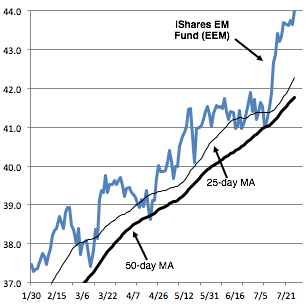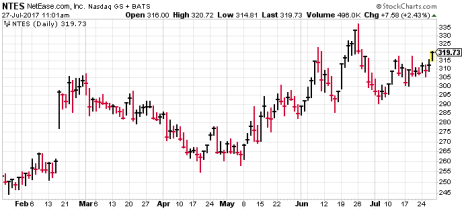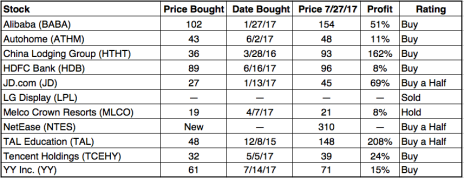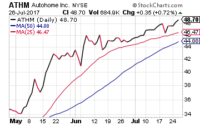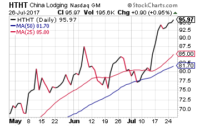Our market timing indicator is positive and our stocks are doing well. We’re heading into earnings season with a powerful wave of momentum providing the power. In this issue I do a little basic review of earnings season and list all the firm dates for companies we own. I also have a new/old stock that boasts very strong numbers and will be reporting in a couple of weeks.
Cabot Emerging Markets Investor 638
[premium_html_toc post_id="136737"]
Cabot Emerging Markets Timer
The Emerging Markets Timer is our disciplined method for staying on the right side of the emerging markets. The Timer is bullish when the index is above the lower of its two moving averages and that moving average is trending up.
Our Emerging Markets Timer is clearly positive as the buyers have rushed in during the past two weeks. The iShares EM Fund (EEM) didn’t do much from mid-May through early July, including multiple tests of its 50-day line, but since the pressure came off the overall market, the fund has shot ahead to new highs and has kept advancing in recent days.
We wouldn’t call the recent move a new buy signal—instead, following an eight-week rest period, the action is more of a continuation of the rally that started back in January. Either way, you should remain heavily invested and look to jump on board new leadership as it emerges.
‘Tis the Season
If you want to know what earnings season feels like to a CEO of a publicly traded company, just imagine that you’re back in high school and there’s a committee watching you, estimating what your report card is going to show, how you’re performing relative to your classmates and asking you for your predictions about how your grades, sports performance, extracurricular activities, dating and college plans will develop over the next semester. That’s how it feels.
The law (in the form of the U.S. Securities and Exchange Commission, the SEC) requires that every stock that trades publicly must make quarterly reports that give its business results for the previous three months and year-to-date and comparing performance to the same period in the previous year. There’s also a requirement for an annual report that goes deeper into reporting of assets, subsidiaries, revenue contributors, number of shareholders and the members of the management team and their compensation.
While devoted fundamental analysts can spend many happy hours panning the gravel of quarterly information for an occasional nugget, the results that matter most to most investors are the headline numbers: Revenue and earnings-per-share vs. analysts predictions and management’s projected results for the next quarter, half or year.
A report that exceeds analysts’ revenue and earnings forecasts and exceeds analysts’ projections for the future is usually hailed by investors and rewarded with a rising share price. A beat can fuel a gap up in price, swell trading volume and provide the fuel for a rally that can have legs.
July 27 was an unusual day for European markets, as some kind of cosmic coincidence caused an unprecedented number of companies to report at the same time. For analysts who have to write reports on the quarterly results that drop during the day, it has been a day from hell. All told, the European companies reporting on Thursday have a combined market cap of nearly $3.5 trillion (with a “T”) and include Anheuser-Busch InBev, Nestle, Danone, Diageo, British American Tobacco, Roche, Bayer, AstraZeneca, Orange, Volkswagen, Airbus and Fiat Chrysler.
Fortunately for us, the flow of quarterly reports from the companies in our portfolio is usually much less concentrated. HDFC Bank (HDB) reported preliminary results from its latest quarter earlier this week, and the stock has been advancing strongly this week.
Melco Resorts (MLCO) and TAL Education (TAL) reported this morning and reactions have been muted thus far.
YY Inc. (YY) will report on August 10 before the open. China Lodging (HTHT) and Tencent Holdings (TCEHY) will release their results on August 16, with Tencent’s report coming before the market opens and China Lodging after the close.
Alibaba (BABA), Autohome (ATHM), JD.com (JD) and Weibo (WB) will all release results in the first couple of weeks of August, but haven’t announced firm dates.
The recent momentum of Chinese ADRs especially will give all of these reports an extra bit of drama. With a lot of hot money in the chase, the reactions to earnings may be more than usually potent. We will have the advantage of sizable profit cushions in many of our holdings, but will still have to pay very close attention to investors’ reactions to protect those profits if results disappoint.
Featured Stock
Easy Does It
NetEase (NTES)
NetEase describes itself as an internet technology company whose online services are “centered around content, community, communication and commerce,” which takes in just about the entire internet. And that’s appropriate for a company that operates one of the major Chinese Web portals that offers all the news, weather, sports, email, messaging and interest groups that such sites offer. The site is the largest email provider in China and offers NetEase Cloud Music, one of the most popular music apps in China. There are also e-commerce, online payment, commodity trading and other services.
But in practical terms, NetEase is an online game company whose results are driven by PC and mobile games. The company caught the attention of western investors in 2009 when it gained the license from Blizzard Entertainment to exclusive operation of World of Warcraft in China. But while the relationship with Blizzard has expanded to include many other games and updates, the bulk of NetEase’s revenue now comes from Chinese-themed games—like Fantasy Westward Journey—that it has developed all by itself.
NetEase gets game revenue from selling playing time and from selling in-game items that enhance characters’ power and appearance. Online game services contributed $1.6 billion of the company’s $2 billion in net revenue in the first quarter. That game services number was up 72% from Q1 2016 and total revenue was up by 52%. The remainder of revenue came from email, e-commerce and other online services ($357.4 million, up 63% y-o-y) and advertising services ($64.7 million, up 13%).
The company has a long history of growing revenue, from the 15% advances in 2012 and 2013 to 26% in 2014, 90% in 2015 and 58% in 2016. After-tax profit margins have topped 30% in eight of the past nine quarters.
In its first-quarter report, NetEase also revealed nearly $6 billion in cash and cash equivalents and raised its dividend to $1.08 per share (up from $1.01 per share in Q4 2016). Also, the company’s share repurchase program was reported to have bought less than $24 million of its up to $1 billion authorization, so there’s plenty of buying power left.
The strength of the company’s numbers prompts the question of why NetEase hasn’t been a routine component of our portfolio. And the answer is that, while the long-term trend for NTES has been clearly upward (from 17 in February 2009, near the end of the Great Recession), the stock has also been quite volatile. Significant pullbacks have occurred in August 2015, the first four months of 2016, November and December 2016 and March and April 2017.
We last bought NTES in June 2016 at 175 and sold at 275 in April 2017 for a substantial profit.
What we like about NTES right now is that the stock had been trading sideways under resistance at 318 since July 13 before today’s push higher. NetEase will report its second-quarter results on August 9 before the market opens, and with a flat base of a few weeks to build on, good news could provide a nice boost. Analysts are calling for revenue of $1.91 billion and earnings of $3.79 per share.
We’re always reluctant to put a major chunk of money into a stock just ahead of earnings, but the stock’s calm action looks like a good opportunity to take a small position. We recommend taking a half position in NTES and will be watching the stock’s action after the August 9 earnings report. BUY A HALF.
NetEase (NTES 310)
No. 1 Zhongguancun East Road
Tsinghua Science Park Building 8
Beijing, 100084 China
86 10 8255 8163
Ir.netease.com
Model Portfolio
Invested 85% Cash 15%
Updates
Emerging market stocks have been surging over the past two weeks, positioning themselves as some of the leaders of the market’s next leg up. Our Emerging Markets Timer is clearly bullish, and while pullbacks and potholes will occur (today brought a little churning—selling on strength, which is normal after the recent run), the odds favor higher prices ahead.
Most of our stocks have gone along for the ride, and our goal now is simply to give our top performers room to breathe, watch out for any abnormal weakness as earnings season progresses and put money to work in new, high-odds setups.
Alibaba (BABA) remains in great shape. It was one of the first stocks to hit new highs once the pressure came off the market earlier this month, and it continues to hover north of its 25-day line, including today’s pop higher on Facebook’s bullish results. We’ll stay on Buy, but try to buy on normal pullbacks. BUY.
Autohome (ATHM) also continues to glide along its 25-day line in recent weeks, with a push to new highs today. Our only worry short-term is that the recent upmove has come on very light volume, so we can’t say demand is overwhelming. But bigger picture, the story is intact and the trend is firmly up. We’ll stick with our Buy rating. BUY.
China Lodging Group (HTHT) chopped around in June and early July, but after tagging its 50-day line, shares have exploded higher on excellent volume as they take aim at the century mark. Earnings are due out August 16, though investors have already signaled their approval of China Lodging’s preliminary hotel results (90% occupancy rate, 10% rise in per-room prices and a 7% sequential rise in number of rooms in operation). You can buy a little here or (preferably) on dips of a couple of points. BUY.
HDFC Bank (HDB) also released preliminary results recently, and they looked just fine, with revenues up 22% in local currency terms, with net income up around 20%. The stock paused briefly in June to kiss its 50-day line but has lifted steadily since. As with most stocks, a dip of a couple of points would be normal, and provide a nice chance to enter. BUY.
JD.com (JD) has ripped back into new high ground, thanks in part to an expansion of the firm’s current partnership with Walmart, as the two companies further integrate their platforms in China ahead of that country’s big August 8 shopping day. If you own some JD, just hang on (we’re holding a half position after booking partial profits a few weeks back), but if you don’t, you could pick up a small position here or on dips of a point or two. Earnings are likely out in a couple of weeks. BUY.
LG Display (LPL) had a nice setup and a decent story, but last week’s sharp drop caused us to cut our loss on our half position and move on to greener pastures. SOLD.
Melco Resorts (MLCO) isn’t a leader here, but it also hasn’t broken key support, at least not yet. Macau-related stocks have cooled off after June’s so-so gaming results, but business looks good—the firm’s second-quarter sales and earnings rose 21% and 220%, respectively, while cash flow rose 34%. We’re willing to give MLCO a chance, but a break of 20 would tell us the Macau comeback is running into trouble. HOLD.
TAL Education (TAL) reported another excellent quarter this morning, with revenues up 65%, student enrollments up 62% (it now has 567 learning centers, up from 507 three months ago) and earnings up 72%, well ahead of estimates. And management said it expects the current fiscal year (ending next February) to see revenues grow nearly 60%, so growth should continue. The stock churned a bit today (it gapped higher but sold off a bit as the day wore on), so maybe TAL is ready to rest a bit. But the bigger picture continues to look very bullish. BUY A HALF.
Tencent Holdings (TCEHY), a little known (to U.S. investors, anyway) big-cap leader, shot to new highs today. Hold on if you own some, and if not, try to get in on a dip of a point or two. Earnings are due out on August 16. BUY.
YY Inc. (YY) has joined in on the emerging market melt-up, breaking out of a base (near 62) on July 14 and ripping as high as 74 before taking a breather. Earnings are due out on August 10, which is always a short-term risk, but we like the action and the growth story a lot. We filled out our position last week; if you don’t own any, you can start with a half position here or on dips of a couple of points. BUY.
[premium_html_footer]
Send questions or comments to paul@cabotwealth.com.
Cabot Emerging Markets Investor • 176 North Street, Salem, MA 01970 • www.cabotwealth.com
All Cabot Emerging Markets Investor buy and sell recommendations are made in issues or updates and posted on the Cabot subscribers’ website. Sell recommendations may also be sent to subscribers as special alerts via email. To calculate the performance of the hypothetical portfolio, Cabot “buys” and “sells” at the midpoint of the high and low prices of the stock on the day following the recommendation. Cabot’s policy is to sell any stock that shows a loss of 20% in a bull market (15% in a bear market) from our original buy price, calculated using the current closing (not intra-day) price. Subscribers should apply loss limits based on their own personal purchase prices.
THE NEXT CABOT EMERGING MARKETS INVESTOR IS SCHEDULED FOR August 10, 2017
We appreciate your feedback on this issue. Follow the link below to complete our subscriber satisfaction survey: Go to: www.surveymonkey.com/chinasurvey
Cabot Emerging Markets Investor is published by Cabot Wealth Network, an independent publisher of investment advice since 1970. Neither Cabot Wealth Network, nor our employees, are compensated in any way by the companies whose stocks we recommend. Sources of information are believed to be reliable, but they are in no way guaranteed to be complete or without error. Recommendations, opinions or suggestions are given with the understanding that subscribers acting on information assume all risks involved. © Cabot Wealth Network 2017. Copying and/or electronic transmission of this report is a violation of the copyright law. For the protection of our subscribers, if copyright laws are violated, the subscription will be terminated. To subscribe or for information on our privacy policy, visit www.cabotwealth.com, write to support@cabotwealth.com or call 978-745-5532.
[/premium_html_footer]

